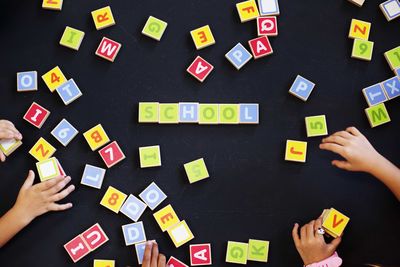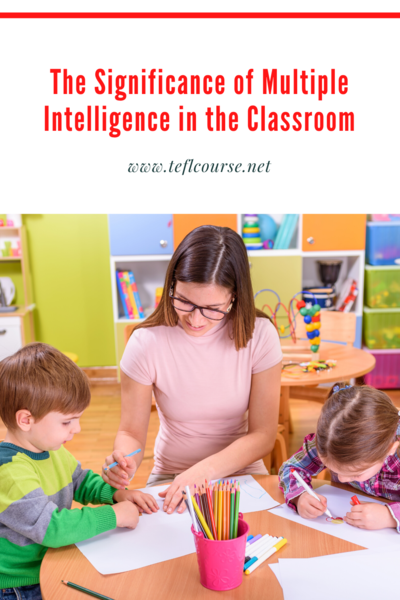The Significance of Multiple Intelligence in the Classroom

This essay focuses on what "multiple intelligence" is, a comparison between multiple intelligences and the traditional notion of intelligence, what these multiple intelligence categories ("modalities") are, and their significance in the classroom context.
Table of Contents
Do you want to teach English abroad? Take a TEFL course!
This post was written by our TEFL certification graduate Stephanie T. Please note that this blog post might not necessarily represent the beliefs or opinions of ITTT.
The MI Theory
"Multiple intelligence" was a theory developed by Professor Howard Gardner in the early 1980s to describe the various innate talents that everyone possesses. Multiple intelligence theory was a reaction to the conventional teaching methods that cater predominantly to the book-smarts, those proficient in mathematical abilities and linguistics.
The traditional view of intelligence presupposes that a person's intelligence is fixed at birth. Also, intelligence consists of the main abilities in logic and language. In the conventional teaching method, the same materials are taught in a one-size-fits-all manner to students. Rote memorization is the typical standard way of retaining new information, including dry lectures where the teacher dominates speaking time while students are handed worksheets to complete. Gardner believed that the traditional way of testing one's intelligence quotient could not adequately measure the vast potential we have. Everyone possesses a mixed bag of intelligence and innate talents, with different ways of learning, retaining information and understanding the world.
In his seminal book Frames of Mind: The Theories of Multiple Intelligences, Gardner summed up these intelligences into eight categories:
Also Read: Can Americans teach English in Europe?
Types of Intelligences
The first two bits of intelligence are typically valued in schools. Learners with logical-mathematical intelligence are good with logic, reasoning work, and critical thinking. Stimulating assignments would be puzzles or experiments that make them a question or derive answers on their own. Verbal-linguistic talents manifest in proficiency with words. Those who have this talent typically score in reading, writing and memorizing. Such learners thrive when given word games, or assignments such as storytelling, journal writing, and discussions.
The next three bits of intelligence revolves around the arts. Young learners gifted with musical intelligence have a sensitivity to rhythm, melody and more. To catch their attention, teaching activities should consist of listening to songs that aim to teach, incorporating vocabulary into songs and repeating them, composing lyrics into raps, including the use of musical instruments. Those students with visual-spatial intelligence tend to be more imaginative and visual. Thus, visual presentations such as videos, pictures and art materials; imagination games, and the use of metaphors would stimulate them. Drawing or doodling, coloring, and mind mapping should be encouraged as these would help them retain/remember information. Students good at sports, dance, or constructing things are said to possess bodily-kinesthetic intelligence. Hence, learning activities need to incorporate tactile activities to help them retain information, such as role-plays, using hand gestures and exaggerated facial expressions, visiting museums, or using clays.

People high in personal intelligence, such as interpersonal intelligence and interpersonal intelligence, are usually sensitive to others' moods, temperaments, feelings and have higher empathy skills. Those who have interpersonal intelligence especially love being part of a community. As such learners get stimulated by dynamic interactions, peer tutoring, and teamwork. In contrast, people who are intra-personal intelligently are introspective and self-reflective; retaining information becomes easier when knowledge is connected with the person, such as when doing presentations.
Last is the person with the "green thumb"(the naturalist) who learn by connecting subject matter with nature study or natural phenomena. They study better by studying outside in natural settings (see Slideshare).
Also Read: Are there any age limits for TEFL teaching?
Traditional Approach
Presently, most classrooms around the world still go by a predominantly mathematical-logical and linguistic educational program. One downside to this is that many learners who have gifts outside this conventional educational program end up being mistakenly thought of as suffering from learning disorders or labeled underachievers (see American Institute for Learning and Development). For example, Tom Cruise, Richard Branson, and Steven Spielberg were diagnosed with dyslexia and did not do well academically but their sheer talent in other areas eventually led them to become successful in their respective fields.
Also Read: Should I take a TEFL course online or in a classroom?
Benefits
Within the context of classroom teaching, multiple intelligence theory provides an impetus for traditional classroom teaching and conventional perception of intelligence to be reformed. Based on a website for educators (see All Kinds of Minds), educators should be trained to first acknowledge the different talents and gifts that each student possesses and therefore help them reach their full potential. Instead of perceiving all students as alike, they should be treated as having different learning styles, and different ways of looking at the world. Second, teachers should be trained to present their lessons in a wide variety of ways using student-centered learning, art activities, simulation activities, multimedia, out of the classroom and self-reflective activities. Different teaching materials and strategies should cater to different learning styles. Simply, educators should unlearn to learn (new skills and information). Third, academic institutions should consider other ways to measure the learning achievements of students.
Do you want to teach English abroad? Take a TEFL course!
In general, multiple intelligence offers a broader and more generous view of intelligence than the traditional notion. More schools in the world should adopt this perspective and redesign their educational programs.
Apply now & get certified to teach english abroad!
Speak with an ITTT advisor today to put together your personal plan for teaching English abroad.
Send us an email or call us toll-free at 1-800-490-0531 to speak with an ITTT advisor today.
Related Articles:
- 10+ Activities For Teaching English Winter Camp
- Top 10 Things To Know When Moving Abroad To Teach English
- 7 Activities for Teaching Reported Speech in the ESL Classroom
- What TEFL course is most useful?
- Great Ideas for Teaching Listening Skills in the ESL Classroom
- The Best Countries to Teach ESL When You're 50+




